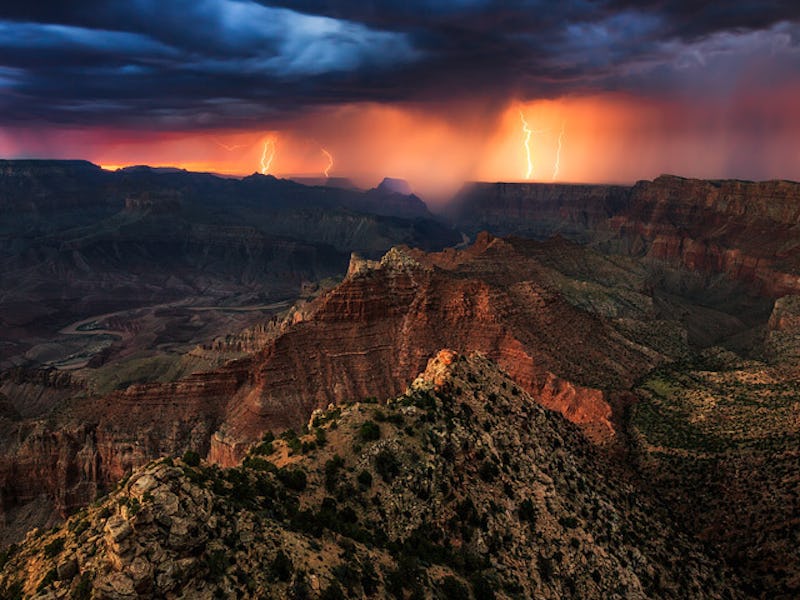Why This Guy Can Take Rocks From the Grand Canyon and You Can’t
Pro tip: Tell the government you're trying to prove Noah's flood was real.

Geologist Andrew Snelling is hunting for evidence of Noah’s great flood. His pursuit has brought him to the deepest gorge in the United States, Grand Canyon National Park, which he sued in May for rejecting his bid to collect around 50 fist-sized rocks for research purposes. In his suit, Snelling quoted President Donald Trump’s executive order expanding freedom of religion, arguing that it was unconstitutional to forbid him from collecting rocks from the land.
The U.S. Park Service has finally relented. In early July, it approved Snelling’s research permit and allowed him to gather these protected cobbles for deep scrutiny. The move is not unprecedented but is highly unusual, given Snelling’s dubious scientific objectives.
If all goes his way, the rocks will show telltale signs of having been tossed about during the aftermath of a flood so massive, it was only survivable for species that hitched a ride on Noah’s nearly 500-foot long ship.
Snelling is convinced he'll find evidence of the Great Flood, imagined here by French painter Leon Comerre.
For most people, taking anything from a national park is prohibited. “Take pictures, leave footprints,” is the famous ranger adage. Even swiping a flower will earn the pilferer a $100 ticket (which can end up costing as much as $5,000). The only way around this rule is to obtain a research permit, which allows researchers to remove artifacts or natural resources from a national park. Getting one isn’t — or shouldn’t — be easy: Usually, people must prove that their research will benefit science or improve the stewardship of the park. Interested applicants, like Snelling, must be prepared to answer questions like these:
Will the proposed activity result in degradation of the purposes, resources, and values of the park?
Could the proposed research be performed outside the park?
What are the potential benefits of the research to science?
Has the proposed research been peer-reviewed for scientific integrity by recognized experts?
Snelling apparently answered these questions well enough to justify research into a “catastrophic erosion” event that formed the Grand Canyon in what he presumes to be a violently swift event.
National Parks regularly approve research permits, for both its own scientists and outside researchers. The Grand Canyon approves around 80 such projects a year. At Point Reyes National Seashore, scientists clip GPS tags to elephant seals, and in Alaska they shoot bears with harmless darts, in hopes of gathering DNA for genetic studies.
The Colorado River, which most geologists believe carved the Grand Canyon over the course of some five million years, is also responsible for carving canyons through much of the Southwestern desert.
The uniqueness of Snelling’s research, of course, is that it conflicts with the natural history and earth science taught by park rangers and independently verified by outside geologists, which suggest that, some five million years ago, the dominant Colorado River began carving through thousands of feet of layered sediments. This process continues its course today, as the same river continues to snake through the canyon.
Snelling’s views of a young Earth, created less than 10,000 years ago by divine forces, is far different from the conceptions of natural history held by most geologists, who have found no evidence that today’s natural features can be explained by any sort of globe-encompassing super-event, like a flood.
Indeed, there are geologic curiosities around the world that young-earth creationist geologists argue were placed there during a great flood — specifically, massive, out-of-place rocks. But today’s receding glaciers reveal that these rocks, called glacial erratics, were pushed there by the indomitable forces of local glaciers, not a great flood.
In the end, the Park Service’s decision to approve Snelling’s research permit may not have been based upon any reasonable scientific merit, but the simple desire to move on. It’s been a three-year bureaucratic tussle, and the 50 rocks — which park scientists still contend could be easily found outside the park — will ultimately be returned to their park home.
Getting these geologic features outside the boundaries of Grand Canyon National Park was no easy task for Snelling, but he did it legally. So, for all the scientific disagreement that may arise, he didn’t violate national park laws in his attempt to prove the word of God.